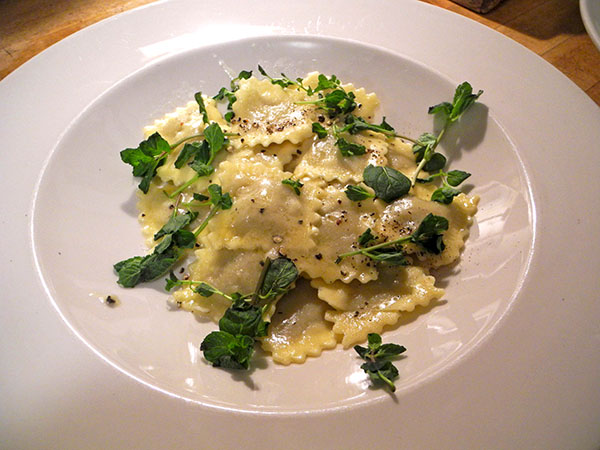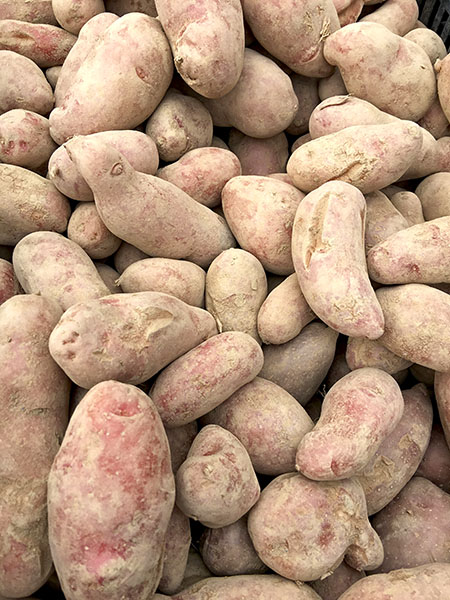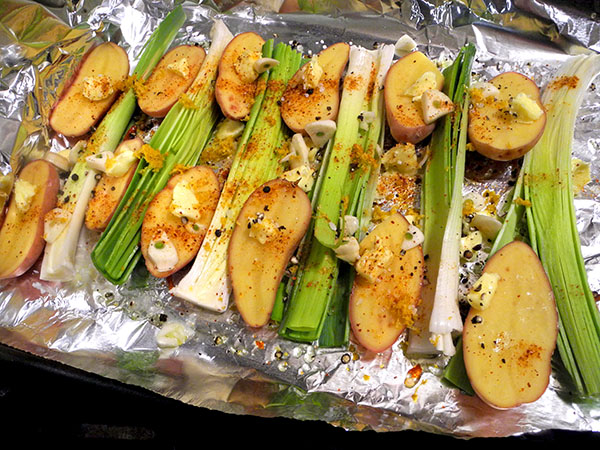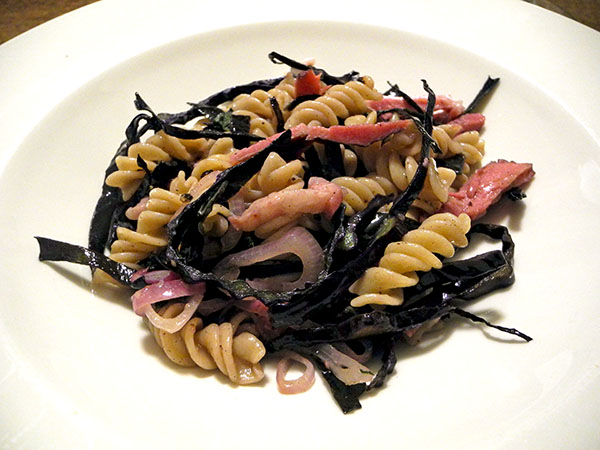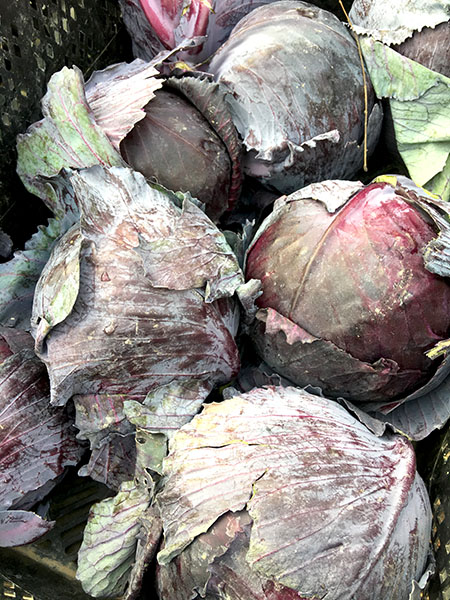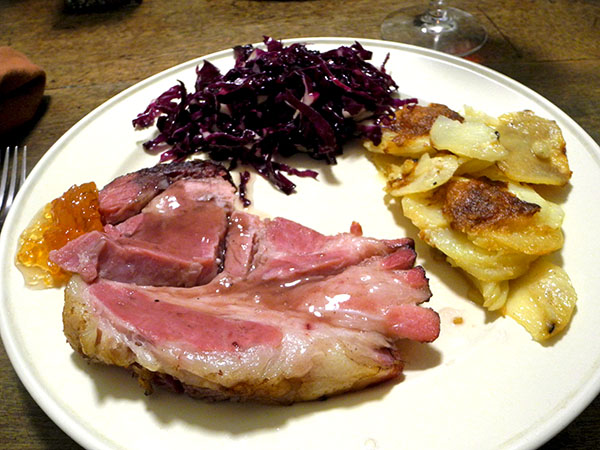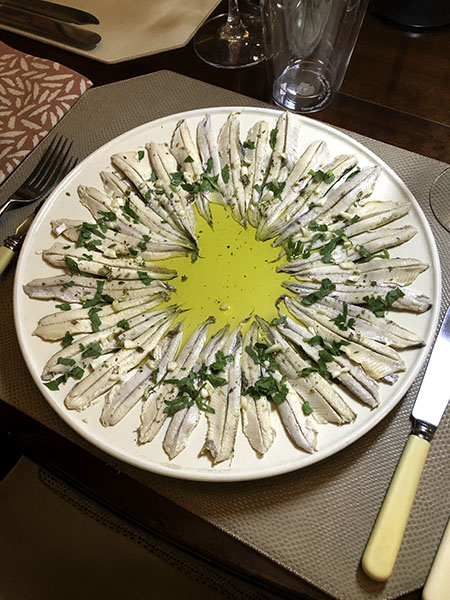
Because it would simplify my work on the entrée when we had guests, leaving me with more time to interact before we sat down to eat, I had hoped to pick up a large striped bass fillet when I headed for the Union Square Greenmarket on Saturday, as in this good dinner. It didn’t happen: I had forgotten that this wasn’t the season for stripers, because of serious conservation management directives.
I had no fallback, so when I noticed that Phil Karlin himself was at his family’s fish stand, I told him I would be serving 4 people that night, and asked if he have a suggestion. “Get the haddock”, he replied, without a second’s hesitation.
I got the haddock.
Thanks Phil. It was superb.
- we celebrated before the meal itself with breadsticks and other crunchy things
- the wine was a Spanish (Penedès) sparkling rosé, Raventos i Blanc, Conca del Riu Anoia Rose ‘de Nit’ 2016, from Flatiron Wines
The meal began with filetti alici marinate as primi, served on a large plate arranged in a pattern I hated to disturb.
- A 9-ounce package of fresh marinated anchovies (It. alici marinate) from Buon Italia in Chelsea Market, the fillets, as they are packaged in sunflower oil, removed from the container, laid on top of paper towels on a large plate in order to drain, their top side gently dried with another paper towel, then carefully arranged on a second large plate, scattered with a little chopped Salinas, California parsley from Eataly, a bit of super-pungent dried Sicilian oregano from Buon Italia, and a bit of finely-chopped Krasnodar red garlic from Quarton Farm, drizzled with Frankies 457 Sicilian olive oil, the plate covered and set near a window where they remained at precisely 58º F (hey, I read somewhere that Italians love 58º F for their alici) for about an hour and a half or 2 hours, brought to the table and distributed onto the 4 plates (there were 33 anchovies, so 8 per person, one for the cook, to taste)
- the greens on the side included mix of wild cress and, in a very tiny form, a variation of cress crossed with shepherd’s purse, both from Lani’s Farm, a bit of ‘Rosa di Campo Rosso’ radicchio from Campo Rosso Farm, and micro pea greens from Windfall Farms
- slices of a delicious buckwheat baguette from Runner & Stone Bakery
- the wine was a Spanish (Galicia) white, Bodegas Avancia, Godello ‘Cuvee De O’ 2016, from Flatiron Wines
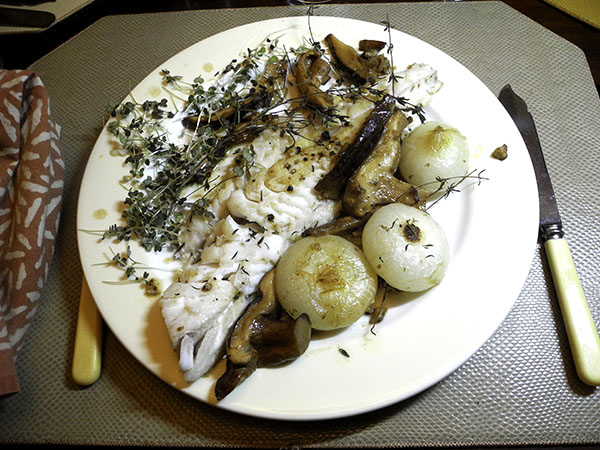
The main course was a triumph.
- twelve or so cipolline onions from Norwich Meadows Farm, boiled for 5 minutes, drained, skinned, and the root ends cut off before 6 tablespoons of oil was heated inside a large antique heavy high-sided copper pot over medium-high heat, at which time the onions, a pound of thickly-sliced shiitake mushrooms from Bulich Mushroom Company in the Union Square Greenmarket, a good pinch of sea salt, and some freshly ground black pepper were added to the pot and stirred frequently until the mushrooms had begun to soften and everything nicely browned (about 7 or 8 minutes), then 2 thirds of a cup of good Spanish Rioja wine vinegar added, the mix cooked, stirring, over medium high heat for about a minute, scraping up any browned bits stuck on the bottom, the pan removed from the heat and set aside while 2 large rectangular enameled steel oven pans were placed on top of the burners [if there had been only 2 fillets, the onions and mushrooms could have been prepared inside an oval copper au gratin pan, and removed to a bowl when done, the pan wiped clean and the haddock placed inside it], the flames turned high and four very very fresh 8-ounce haddock fillets from P.E. & D.D. Seafood, skin on, already rubbed on both sides with 2 or 3 tablespoons of olive oil and seasoned with salt and pepper, added to the pan once it was very hot, skin side up, seared until a good brown crust had developed, or for about 3 minutes, the fillets turned over and the reserved onions, mushrooms, and pan juices arranged around the fish, and not on it, everything scattered with many (24 small) fresh late-season rosemary branches from Keith’s Farm, the pan placed inside a 400º oven and roasted for about 12 minutes or so [the original recipe, for 2 fillets, appears here]
- the plate garnished with micro red mustard from Two Guys from Woodbridge
- the wine was a California (Central Coast/Santa Ynez Valley) white, Rick Boyer Santa Ynez Valley Dry White Blend 2017, from Naked Wines
by Rick Boyer
The dessert represented the first time, and probably the last (I can’t find the maker active anywhere on line) that we would enjoy what was a certain really, really good gelato.
- Victory Garden New York City goat milk gelato, ‘BAAH-NILLA! (vanilla), ‘classic and classy’, which has a Carmine Street address, from Foragers Market
- ‘Nibblin’ Nuggets of pure maple from Roxbury Mountain Maple in the Greenmarket
We remained at the table even after it had been cleared by the staff (the cook), sipping a Chicago whiskey we had discovered recently.
- Koval, a single barrel bourbon from a distillery in Chicago, described as the first in the state since the nineteenth century, made with organic grains (millet and corn) from a Midwest farmers’ collective of small scale farms, water sourced from Lake Michigan, and aged in new American oak from Minnesota forests, from Astor Wines & Spirits
- the music throughout was (mostly) more live streaming of the awesome octonary WKCR Bachfest 2018
